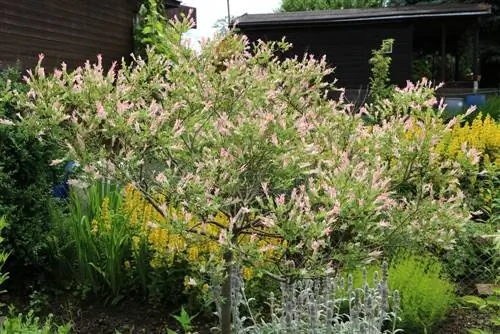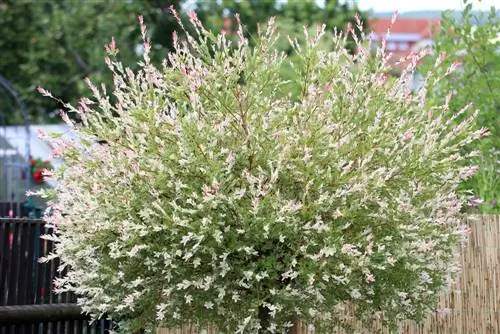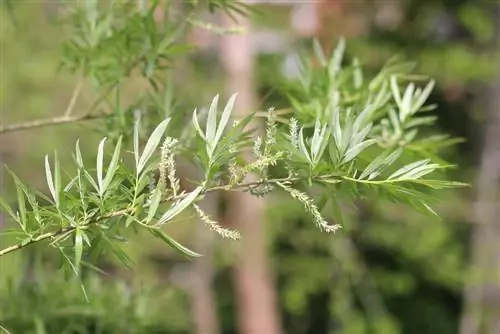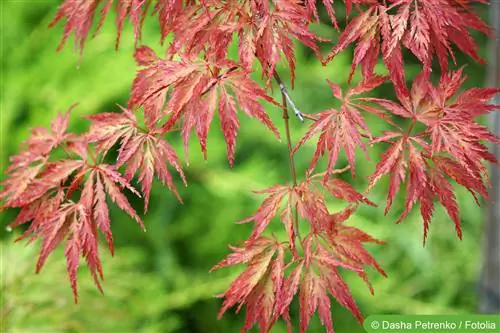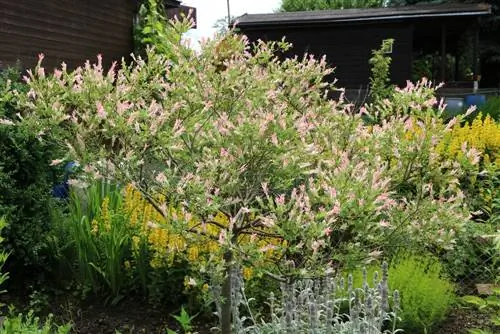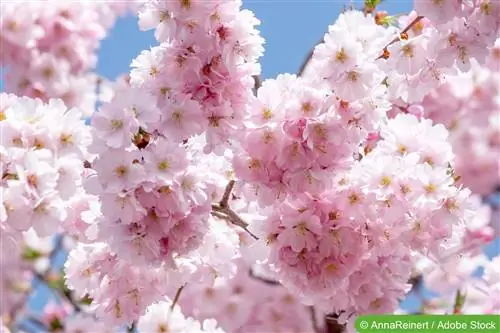- Author admin [email protected].
- Public 2023-12-17 03:39.
- Last modified 2025-01-24 12:45.
The Japanese ornamental willow, also known as harlequin willow, is a decorative ornamental tree and can be seen more and more often in local gardens. The beauty of this plant is undoubtedly the impressive crown, which needs to be cared for carefully so that its attractiveness comes into its own.
Propagation of the Japanese willow
It is relatively easy to propagate the harlequin willow. Actually there are only a few things to pay attention to:
- The period should be in early spring so that the young shoots can bloom straight away.
- Well-ripened shoots are cut off with a sharp knife.
- The lower leaves are removed.
- These cuttings can now be stuck directly into the ground and watered.
- Another option is to leave the cuttings in a glass of water until the first roots appear.
- The young plants can then be “grown” in a pot or they can immediately find their place in the garden soil.
Harlequin willow plants
The harlequin willow is very easy to care for and forgives many mistakes, but it does not like being transplanted. If a cutting is grown in a glass of water in order to then gain strength in a pot, it should be moved to a location in the fall where it can remain. The soil should be loosened well so that the roots can absorb the water particularly well at the beginning. The Japanese ornamental willow reacts very sensitively when transplanted and the flowers fail for the year in which it was transplanted. Luckily she doesn't hold a grudge and recovers, but that doesn't have to be the case.
Which location do the ornamental willows prefer?
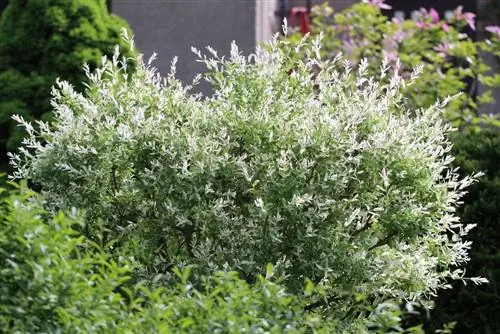
The Harlequin willow likes it sunny to partially shaded. Full sun or pure shade can cause brown leaves. It is ideal if the willow plant is treated to sun for half of the day and some shade for the other half of the day. The soil should not be too heavy because then there is a risk of waterlogging. That's why loosening the soil is the first thing on the agenda before planting the Japanese ornamental plant.
Watering and fertilizing
The Harlequin willow needs a lot of water. Young shoots in particular should be watched closely and watered adequately. There is certainly a fine line between adequate watering and waterlogging. The plant shows incorrect watering behavior relatively quickly through brown leaves or leaf tips and if the watering amount is reduced or increased, the harlequin willow recovers surprisingly quickly. Fertilizer is applied no more than twice a year. Once in spring, just before it starts to bloom, and perhaps again in summer. From August at the latest, the Japanese ornamental willow may no longer be fertilized, otherwise it will not have enough time to prepare for the winter.
How does a harlequin willow overwinter?
- The tree is hardy, but it should be protected from severe frost.
- If the willow is in a bucket, it should be covered with sufficient leaves at the beginning of winter.
- If it is a young plant, the soil around the trunk should be covered with pine branches.
- Older plants do not need any special protection in winter, they are very robust.
Cutting Japanese willow
- The harlequin willow gets its basic cut in spring, ideally after the last frost. You can then cut all the branches quite short so that the remaining shape looks like the original crown that will sprout later. In this way you prevent your ornamental willow from becoming more and more “green”, but at the same time avoid damage to the interfaces.
- In addition, all dead and old branches should be removed, and if the tree crown is too large or loses its shape, the pruning should be severe.
- If you want the crown to appear fuller, you can then prune specifically in the summer months, as this type of willow actually develops new shoots all summer long.
- If you remove shoots, you could immediately use them for propagation: you put them in the ground or in a container with water, roots usually develop quite quickly, which you can then plant as a new ornamental willow.
- A topiary can be done, but it doesn't have to be. It is important that the branches are cut in such a way that a stub does not always remain at the base, because then in the long term a kind of hedgehog head will arise in which you can no longer cut with secateurs. It is better to cut out branches that are too close together.
- Your ornamental willow, if it is a standard tree, is grafted onto another trunk. Then regular care for such an ornamental willow includes immediately breaking off any side shoots that grow out of the original trunk. Because you cost your tree the strength it needs to form its crown.
The harlequin willow is one of the fast-growing plants, which is why topiary pruning is only possible if you are constantly using secateurs.
Diseases of woody plants
Since the willow bush is an extremely robust plant, there are no known sources of disease lurking all the time. If watered incorrectly, the plant reacts with brown leaves or leaf tips. It doesn't matter whether she didn't get enough water or way too much water.
Occasionally the willow is attacked by a fungal disease, then the shoots and branch tips look as if they have been burned. This means that the affected branches must be cut off deep into the he althy wood. The attentive gardener will notice if there are many ants on the willow plant. These are a sign of aphids. In the early stages, these can be combated relatively easily: spray the plant with a strong jet of water. “Wash” the entire plant with a solution of water and soft soap. Anyone who watches their harlequin willow carefully has a clear advantage. This means that illnesses and ailments can be identified and treated straight away.
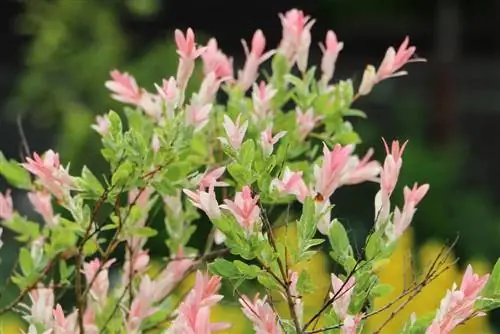
The Japanese ornamental willow is a robust and pretty plant. In order for it to grow beautifully round, the branches must be inspected daily. Therefore, the plant is not for someone who would like to have an attractive tree in their garden but doesn't have the time or desire for it. If treated appropriately, the harlequin willow is a real eye-catcher in the garden, which is why it should be given its own place.
What you should know about the Japanese ornamental willow in brief
- The ornamental willow does not place many demands on its location. It feels comfortable in both the sun and partial shade.
- It doesn't matter whether the floor is light or heavy, it can handle both. A sandy soil is particularly suitable.
- Severe soil compaction and waterlogging lead to stunted growth and susceptibility to disease.
- The harlequin willow needs a lot of water.
- The willow reacts sensitively to transplanting. The leaves are curling up and it doesn't look good anymore. But it usually recovers by the next shoot in spring.
- The best time for repotting or moving is from mid-October.
Avoid care mistakes for the harlequin willow
The annual fertilizer application should be done carefully and only after cutting - any excess fertilizer could harm the Japanese ornamental willow. It is not uncommon for Japanese ornamental willows to show brown shoot tips, which are caused either by too strong sun or by a (even short) dry season. This in itself isn't worrying, you could just let the brown tips grow out, although that will take a little time. You can also cut them off, but then you have to be careful not to cut too deeply, i.e. not into the original trunk below the graft.
If brown leaves appear permanently, you should check the nutrient supply of the ornamental willow. You should also make sure that your ornamental willow is not exposed to waterlogging, which it does not tolerate very well, especially in a pot.

